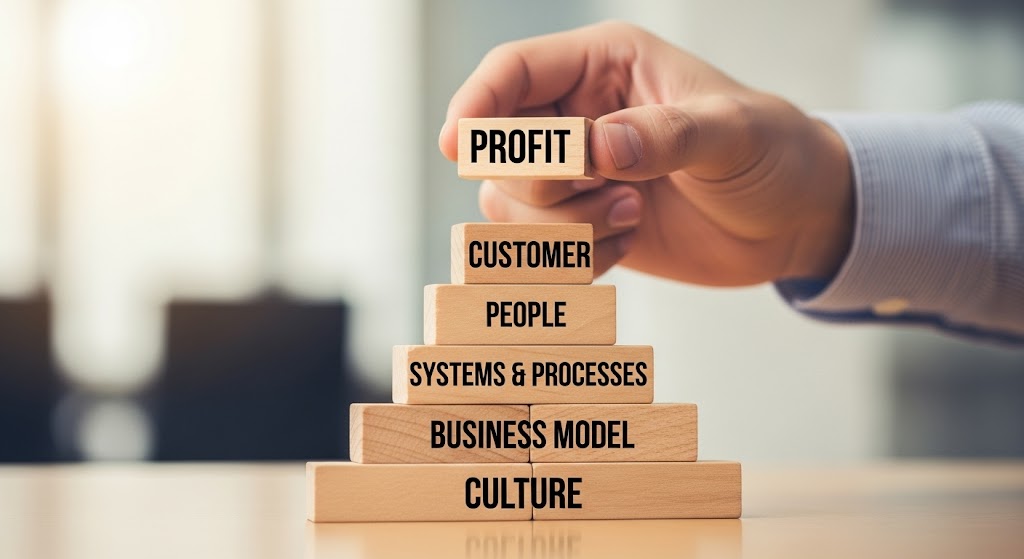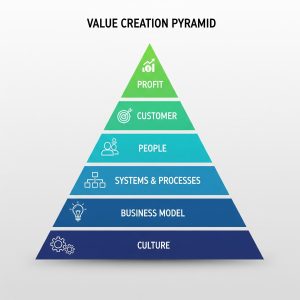When profits dip or customer satisfaction wanes, leaders often scramble for surface-level fixes. We tweak marketing, adjust prices, or retrain a sales team, yet the underlying problems persist. The issue is often not our diagnosis of the symptom, but our failure to understand the foundational structure of value delivery.
A powerful way to conceptualize this is through what I call a Value Creation Pyramid—a hierarchy of interconnected levels that work together to deliver value to a customer and, ultimately, generate profit. By understanding this structure, a leader can not only build a more resilient business but also develop a remarkably effective method for troubleshooting any problem that arises.
The pyramid is built from the ground up, with each level supporting the one above it.
Level 1: Culture (The Foundation)
At the very bottom of the pyramid lies Culture. This is the soil in which your entire organization is planted. Culture isn’t a mission statement on a wall; it’s the collection of shared values, beliefs, behaviors, and assumptions that permeate your company. It dictates how people treat each other, how they approach problems, and what they prioritize when no one is watching. A strong, healthy culture—whether it’s one of radical innovation, meticulous service, or ruthless efficiency—provides the stability upon which everything else is built. A toxic or undefined culture will undermine even the most brilliant strategy.
Level 2: Business Model (The Architectural Plan)
Built directly upon your culture is your Business Model. This is the strategic framework for how your organization creates, delivers, and captures value. It answers the fundamental questions: Who is our customer? What value are we offering them? How will we deliver that value, and through what channels? How will we make money doing it? Your culture directly informs your business model. A culture of deep customer empathy will naturally lead to a service-oriented business model, whereas a culture of technological disruption will produce something entirely different.
Level 3: Systems & Processes (The Machinery)
A business model is just a plan. To bring it to life, you need Systems and Processes. This is the operational machinery of your company. It includes your sales funnel, your customer relationship management (CRM) software, your manufacturing workflow, your accounting procedures, and your communication protocols. These systems are the repeatable methods you design to execute your business model efficiently and consistently. They are the gears and levers that turn your strategic plan into tangible action.
Level 4: People (The Operators)
Even the most sophisticated machinery is useless without skilled operators. Your People are the ones who run the systems and processes. Their talent, training, engagement, and dedication are what make the machinery work. You hire, train, and manage your people to effectively operate within the systems you’ve built. A company can have world-class processes, but if its people are unmotivated, untrained, or mismatched for their roles, the system will inevitably fail.
Level 5: The Customer (The Apex)
At the peak of this pyramid of delivery is the Customer. This is the focal point of all preceding levels. Your people, operating your systems, which were designed to execute your business model, which is built on your company culture, all culminate in an interaction with the customer. This is where the value you have so carefully constructed is finally delivered. The quality of this interaction is a direct reflection of the health of every level below it.
Level 6: Profit (The Result / Reward)
There is one final element that sits just above the pyramid: Profit. Profit isn’t a level you build; it’s the result you earn when the entire pyramid is functioning correctly. It is the ultimate indicator that you have successfully delivered value to a customer in an efficient manner. Profit is the reward for building a sound structure, never the foundation itself.
The Diagnostic Power of the Pyramid
The true genius of this model lies in how it’s used for troubleshooting. When a problem arises, we tend to focus on the level where the symptom appears. However, the root cause is almost always found at a level below. To diagnose a problem, you work your way down the pyramid.
- Are you having a Profit problem? The issue is rarely profit itself. Look down one level. The problem is almost always a Customer problem—you aren’t acquiring enough, retaining them, or delivering sufficient value.
- Are you having a Customer problem? Don’t immediately blame the customers. Look down one level. The problem is almost always a People problem—your team is failing to execute, communicate, or provide adequate service.
- Are you having a People problem? It’s tempting to blame individuals, but the cause is rarely the people themselves. Look down one level. The problem is almost always a Systems and Processes problem. You’ve given your team broken tools, inefficient workflows, or unclear procedures, making it impossible for them to succeed.
- Are you having a Systems and Processes problem? Are your systems clunky, inefficient, or misaligned? The cause is not always the system itself. Look down one level. The problem may be a Business Model problem. Your processes are failing because they were designed to support a flawed or outdated business model.
- Is your Business Model struggling? If your fundamental approach to the market isn’t working, or if you have issues at any of the levels above, you can trace the root cause to the base of it all. The problem is almost always a Culture problem. Your strategy is failing because it’s at odds with your underlying values, or your toxic culture is preventing talented people from building and operating effective systems. Holistically, all of your problems are rooted in culture.
By using this top-down diagnostic approach, leaders can stop wasting resources on treating symptoms and start addressing the root cause, ensuring a stronger, more resilient, and ultimately more profitable organization.



